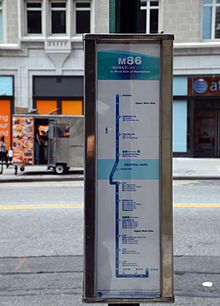
Guide-A-Ride is the bus stop information display for MTA Regional Bus Operations of New York City. It is a rectangular box attached to the bus stop pole that displays a route map and a schedule. Originally designed for MTA New York City Transit operations, it is also used for routes of the MTA Bus Company that were formerly privately operated. [1]
The Guide-A-Ride canister is vandal-resistant [2] and was designed for easy updating of the information displayed; though as a partly analog tool still requiring visits to the site – requiring some planning during the massive system-wide service reductions the MTA was forced to implement at the end of December 2009. [3]
History

The New York City Transit Authority (NYCTA, NYCT, or TA) first announced a plan for "metal diagrammatic maps of bus routes on bus-stop stanchions" in 1964. These consisted of large metal signs (14 x 8 1⁄2 inches) with pictographic depictions of bus routes. [4] [5] [6] [7] Sometimes installed in the place of conventional bus stops, these signs were often considered confusing, as they attempted to consolidate multiple route maps onto a single sign and sometimes omitted routes. [8]
The prototype for Guide-A-Ride was developed in 1977, [9] the key novelty in the display of times to the minute the bus was due at the individual stop. [10] The first sign was installed along the Q44A (now Q46) route in Queens. [11]
Although skeptics doubted the ability of buses on New York City’s densely packed streets to show up anything like the times posted, on-time performance proved to be reliable. [2] Regardless, customers were able to confirm whether they were at the right place at the right time. [10] The actual displays began appearing at bus stops a few years later. [2] The TA did not have a good reputation at the time, but Guide-A-Ride came to be viewed as one positive thing. [12]
Current status
Even despite being superseded by BusTime, Guide-A-Ride is still found at the vast majority of MTA Bus and New York City Bus stops, providing bus schedules and maps. Similar transit aids can be seen in at bus stops in other cities including Boston, [13] Atlanta, [14] and Los Angeles. [15]
References
- ^ "How to Ride the Bus, Welcome Tourists and Visitors". MTA New York City Transit Authority. Retrieved August 12, 2013.
- ^ a b c Fowler, Glenn (October 2, 1980). "New Bus Signs To Help Riders Find Their Way" (PDF). New York Times. Retrieved August 12, 2013.
- ^ "Preparing the 2010 NYCT Service Reductions: Lessons Learned from Prior Exercise, or How We Spent our Christmas Vacation" (PDF). MTA New York City Transit Authority. July 2010. Retrieved August 12, 2013.
- ^ "Bus Stop" (PDF). The New York Times. April 30, 1964. Retrieved November 9, 2015.
- ^ Perlmutter, Emanuel (April 29, 1964). "City Installing New Route Signs at Bus Stops: Transit Agency Also Hopes to Improve Maps in Subway" (PDF). The New York Times. Retrieved November 10, 2015.
- ^ "B46 BUS STOP, Williamsburg". Forgotten New York. Retrieved September 23, 2016.
- ^ "GREENPOINT AVENUE bus map". Forgotten New York. Retrieved September 23, 2016.
- ^ Schumach, Murray (May 28, 1966). "Midtown Buses Outrun Their Signs and Their Riders: Lack of Directions for New Routes Causes Confusion" (PDF). The New York Times. Retrieved November 10, 2015.
-
^
"MTA Home Page". July 7, 2009. Archived from the original on July 7, 2009. Retrieved September 23, 2016.
{{ cite web}}: CS1 maint: bot: original URL status unknown ( link) - ^ a b Blumenthal, Ralph (November 14, 1977). "Information 'Kiosks' Help Bus Riders Solve Puzzle" (PDF). New York Times. Retrieved August 12, 2013.
- ^ "New York City Transit Facts & Figures: 1979" (PDF). La Guardia and Wagner Archives. Metropolitan Transportation Authority, New York City Transit Authority. 1979. Retrieved October 24, 2016.
- ^ "The Worm and the Apple". The New York Times. June 1, 1985.
- ^ "Key Bus Route Improvement Program". Massachusetts Bay Transportation Authority. Retrieved August 12, 2013.
- ^ Hymon, Steve (August 24, 2010). "The Art of Transit". The Source. Retrieved August 12, 2013.
- ^ Geller, Larry (June 6, 2012). "Honolulu city government: near zero bang for the buck". Disappeared News. Retrieved August 12, 2013.

